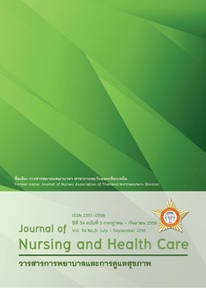การพัฒนารูปแบบการส่งเสริมการเลี้ยงลูกด้วยนมแม่สำหรับมารดาหลังคลอดของ โรงพยาบาลพะเยา Development of a Breastfeeding Promoting Model for Postpartum Mothers in Phayao Hospital
คำสำคัญ:
การพัฒนารูปแบบ มารดาหลังคลอด การส่งเสริมการเลี้ยงลูกด้วยนมแม่ development of a model, breastfeeding promotion, postpartum womanบทคัดย่อ
บทคัดย่อ
การวิจัยเชิงปฏิบัติการนี้ มีวัตถุประสงค์เพื่อการพัฒนารูปแบบการส่งเสริมการเลี้ยงลูกด้วยนมแม่ของมารดาโรงพยาบาล
พะเยา กลุ่มผู้ร่วมวิจัยเป็นหญิงตั้งครรภ์ อายุครรภ์ตั้งแต่ 34 สัปดาห์ ติดตามศึกษาต่อเนื่องไปจนถึงหลังคลอด 6 เดือน
จำนวน 58 ราย โดยแบ่งออกเป็นกลุ่มควบคุม 19 คน กลุ่มทดลอง 29 คนดำเนินการศึกษาระหว่าง เดือนพฤษภาคม พ.ศ.2557 ถึงมกราคม พ.ศ. 2559 เครื่องมือที่ใช้ในการวิจัยประกอบด้วย โปรแกรมการส่งเสริมการเลี้ยงลูกด้วยนมแม่ แนวคำถามสำหรับการสนทนากลุ่ม แบบสอบถามความรู้เรื่องการเลี้ยงลูกด้วยนมแม่ และแบบประเมินพฤติกรรมการเลี้ยงลูกด้วยนมแม่ รวบรวมข้อมูลโดยการสนทนากลุ่ม ตอบแบบสอบถามความรู้เรื่องการเลี้ยงลูกด้วยนมแม่ในช่วง 1 สัปดาห์ 1 เดือน และ4 เดือน หลังคลอด และประเมินพฤติกรรมเลี้ยงลูกด้วยนมแม่ตามแบบประเมิน วิเคราะห์ข้อมูลโดยใช้สถิติบรรยาย สถิติทดสอบที วิเคราะห์ความแปรปรวนทางเดียวแบบวัดซํ้า ทดสอบไคสแควร์ และวิเคราะห์เนื้อหาสำหรับข้อมูลเชิงคุณภาพผลการศึกษามีดังนี้ ขั้นตอนการวิเคราะห์สถานการณ์ พบว่า มารดาหลังคลอดที่ได้รับการดูแลตามปกติไม่ทราบช่องทางติดต่อกับบุคลากรทีมสุขภาพ มีคะแนนเฉลี่ยความรู้การเลี้ยงลูกด้วยนมแม่ และพฤติกรรมการเลี้ยงลูกด้วยนมแม่อยู่ในระดับปานกลาง รวมทั้งบุคลากรทีมสุขภาพส่วนหนึ่งขาดทักษะในการส่งเสริมการเลี้ยงลูกด้วยนมแม่ ขั้นตอนการวางแผนและดำเนินการพัฒนารูปแบบการส่งเสริมการเลี้ยงลูกด้วยนมแม่ มี 4 ระยะ คือ ระยะที่ 1 ระยะตั้งครรภ์ระยะที่ 2 ระยะคลอดระยะที่ 3 ระยะหลังคลอด ระยะที่ 4 ระยะหลังจำหน่ายเพื่อให้สามารถส่งเสริมการเลี้ยงลูกด้วยนมแม่อย่างต่อเนื่อง ขั้นตอนการประเมินผลภายหลังการใช้รูปแบบการส่งเสริมการเลี้ยงลูกด้วยนมแม่ พบว่า มารดาหลังคลอดมีคะแนนเฉลี่ยความรู้การเลี้ยงลูกด้วยนมแม่ (p < .001) และคะแนนเฉลี่ยพฤติกรรมการเลี้ยงลูกด้วยนมแม่ (p < .001) สูงกว่ากลุ่มที่ได้รับการดูแลตามปกติ อย่างมีนัยสำคัญทางสถิติ และมารดาหลังคลอดที่ได้รับการดูแลโดยใช้รูปแบบการส่งเสริมการเลี้ยงลูกด้วยนมแม่มีอัตราการเลี้ยงลูกด้วยนมแม่อย่างเดียว ที่ 4 สัปดาห์ (p < .01) และ 6 เดือน (p < .01) สูงกว่ากลุ่มที่ได้รับการดูแลตามปกติอย่างมีนัยสำคัญทางสถิติการศึกษาครั้งนี้ได้รูปแบบการส่งเสริมการเลี้ยงลูกด้วยนมแม่ของมารดา โรงพยาบาลพะเยา ซึ่งจะช่วยให้ทีมสุขภาพสามารถพัฒนาคุณภาพการส่งเสริมการเลี้ยงลูกด้วยนมแม่อย่างต่อเนื่อง
Abstract
This action research aimed to develop a breastfeeding promoting model for postpartum mothers in Phayao Hospital. Participants were 58 pregnant women with gestational age 34 weeks who were followed until the 6th month of postpartum period. (29 women fo controled and experimental group) Research was conducted from May 2014 to January 2016. Research instruments included the breastfeeding promoting program, focus group discussion guide, breastfeeding knowledge questionnaire, and breastfeeding behavior assessment form. Data were collected through focus group discussion, questionnaire administration at 1-week 4-weeks and 6-month postpartum,and breastfeeding behavior assessment using assessment form. Data were analyzed using descriptive statistics,t-test, repeated measure ANOVA, Chi-square test, and content analysis for quantitative data.
Findings from each phase were as followed. The situational analysis phase revealed that postpartum mothers receiving usual care did not have contact access to health personnel, the mean scores of breastfeeding knowledge and breastfeeding behaviors were at the moderate level. Additionally, some health personnel did not have adequate breastfeeding promotion skills. The breastfeeding promoting model development and employment phase was differentiated into 4 stages to continue breastfeeding promotion including 1) antenatal period, 2) labor period,3) postpartum period, and 4) after hospital discharge period. The evaluation phase demonstrated that after receiving breastfeeding promotion according to the model, the postpartum mothers had a significantly higher mean score
of breastfeeding knowledge (p<.001) and breastfeeding behaviors (p<.001) of than those of postpartum mothers receiving usual care. Moreover, postpartum mothers receiving breastfeeding promotion in the model had significantly higher rate of exclusive breastfeeding at 4-week (p < .01) and 6-month (p < .01) after childbirth than those of the
mothers receiving usual care. In conclusion, this study provides a breastfeeding promoting model for postpartum mothers in Phayao Hospital that will enable health personnel to continuously improve the quality of breastfeeding promotion.



